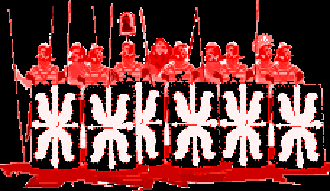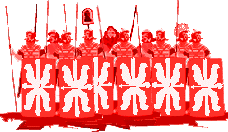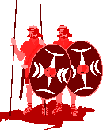Roman Military Terms Glossary


 |
Aelia: The family name of the Emperor Hadrian, indicates a unit raised or honored by this Emperor |
| Aestiva: A campaign base occupied for the summer, found in Britain during the early first century, some of the sites known in Britain as vexillation fortresses may have been aestiva, see also hiberna | |
| Ala: Auxiliary cavalry regiment, from the Latin for wing | |
| Asturum: Indicates a unit raised from the Astures, inhabitants of northwest Spain | |
| Barcariorum: The name of a unit that indicates they used barcae, third century lighters or barges, possibly used for military actions in coastal waters as well as for logistical support | |
| Batavorum: Indicates a unit raised from the inhabitants of present-day Netherlands, such units were renowned for their river crossing capabilities | |
| Bracaraugustanorum: Indicates a unit raised from the Bracares, inhabitants of present-day northwest Spain, the name comes from that of the tribal capital Bracara Augusta | |
| Canabae: A settlement that arose beside a legionary fortress, see also vicus | |
| Centurions: Commanded centuries in legions and cohorts, and were the senior professional officers in a unit; the third in command of an entire legion (praefectus castrorum) was often an ex-centurion | |
 Civium Romanorum:
Auxiliary units could be granted, as a group, citizenship for achievements on the battle field, the title would remain even though the grant
of citizenship was only to those troops serving at the time; the title was also used for a small number of auxiliary units raised
originally from citizens Civium Romanorum:
Auxiliary units could be granted, as a group, citizenship for achievements on the battle field, the title would remain even though the grant
of citizenship was only to those troops serving at the time; the title was also used for a small number of auxiliary units raised
originally from citizens |
|
| Classis: The fleet, the name was accompanied by a geographical identification, thus Classis Britannica and Classis Germanica; the fleet had an important logistical role | |
| Clavicula: Curved extension of camp defenses to protect entrances usually only of temporary camps, see titulum | |
| Contubernium: A tent for eight soldiers, later also the name for a room in barrack blocks also housing eight men | |
| Dacorum: In a unit's name indicates it was raised in Dacia, present-day Romania | |
| Delmatorum: In a unit's name indicates it was raised in Dalmatia | |
 |
Equestrian: The social group beneath the senatorial class in seniority, the "landed gentry" of the Empire, in the early Empire eligible for the post of Praefect (commander) of auxiliary regiments; following Diocletian's separation of the military and civil careers and his banning of senators from military positions, equestrians became eligible for all army commands |
| Exploratum: Units of scouts or reconnaissance troops, in Britain primarily associated with the outpost forts on Hadrian's Wall | |
| Flavian: From the family name, Flavius, of the Emperors Vespasian, Titus and Domitian who reigned from 69 AD to 96 AD | |
| Flavia: The family name of the Flavian Emperors indicates a unit raised or honoured during this period | |
| Fort: Base for an auxiliary unit, usually between 1 and 4 ha in size | |
| Fortlet: Base for part of an auxiliary unit, usually less than 1 ha in size, distinguished from forts due to their lack of a principia | |
| Fortress: Base for a legion, usually around 20 ha in size | |
| Frisiorum: Indicates a unit raised from the Frisii, inhabitants of present-day Netherlands | |
| Hamiorum: Indicates a unit raised from the Hamii, inhabitants of present-day Syria, renowned for their archery skills and unlike other units whose links to their original home became remote, they may have continued to recruit from Syria | |
| Hiberna: A winter base for troops on campaign, found in Britain during the early first century, before permanent forts and fortresses were built, some of the sites known in Britain as vexillation fortresses may have been hiberna, see aestiva | |
 Legate: Commander of a legion,
drawn from the senatorial class, eligible after successful completion of this and other posts in strict
order, for selection as governor of a province; Cerialis and Agricola
both commanded legions in Britain before becoming governors of
the province; Vespasian, legate of Legio II Augusta during the
conquest, made a successful bid to be Emperor in 69 AD Legate: Commander of a legion,
drawn from the senatorial class, eligible after successful completion of this and other posts in strict
order, for selection as governor of a province; Cerialis and Agricola
both commanded legions in Britain before becoming governors of
the province; Vespasian, legate of Legio II Augusta during the
conquest, made a successful bid to be Emperor in 69 AD |
|
| Lingonum: In a unit's name indicates it was raised in upper Germany | |
| Milliaria: A cohort or ala of close to 1,000 men, exact numbers differ depending on the type of unit (see Quingenaria) | |
| Names, Roman: From the end of the first century citizens had three parts to their names (praenomen, nomen and cognomen) for example Marcus Ulpia Traianus, the Emperor more commonly known in English as Trajan | |
| Nervia: In a unit's name indicates it was raised by the Emperor Nerva | |
| Nerviorum: Indicates a unit raised from the Nervii, inhabitants of present-day Belgium | |
| Pannoniorum: Indicates a unit raised from Pannonia, present-day Hungary | |
| Praetorian Guard: The Emperor's household troops, abolished by Constantine; see also Urban Cohorts | |
| Principia: The headquarters building in a fortress or fort | |
| Quingenaria: A cohort or ala of close to 500 men in strength, exact numbers differed depending on the type of unit (see Milliaria) | |
| Raetorum: Indicates a unit raised from Raetia including present-day Bavaria and the Tyrol | |
| Sarmatarum: Indicates a unit raised from the Sarmartians captured during Marcus Aurelius's campaigns in the present-day Czech and Slovak Republics in the second half of the second century | |
| Singulares: Guards, cavalry and infantry, serving the Emperor and provincial governors | |
| Senators: The foremost groups of Roman citizens, eligible to command legions (legate) and to govern provinces | |
| Thracum: Indicates a unit raised from Thrace, mainly present-day Bulgaria | |
| Tigrisensium: In a unit's name indicates previous service on the River Tigris | |
| Titulum: A stretch of ditch some distance in front of a gateway to give protection to the gateway usually only of temporary camps, see clavicula | |
| Torquata: A title awarded to units rather than individuals for achievements on the battle field, the torque would appear on the unit's standard | |
| Tres militiae: The military career path of an equestrian, commander (praefect) of an auxiliary cohort; legionary tribune; praefect of an ala | |
 Tribune: One of the six senior ranking officers
after the legate of a legion; one tribune, the second in command, was entitled the tribunus laticlavius and was drawn from
the senatorial classes and beginning his career, the other five arose from the equestrian classes and were in midst
of their career progression, see tres militiae Tribune: One of the six senior ranking officers
after the legate of a legion; one tribune, the second in command, was entitled the tribunus laticlavius and was drawn from
the senatorial classes and beginning his career, the other five arose from the equestrian classes and were in midst
of their career progression, see tres militiae |
|
| Tungrorum: Indicates a unit raised from the Tungri, inhabitants of present-day Belgium | |
| Urban Cohorts: Five cohorts based in and around Rome, from the Flavian period the number in Italy is reduced to four with one in Carthage and another at Lyons | |
| Ulpia: The family name of the Emperor Trajan, in a unit's name indicates it was raised or honored by this Emperor | |
| Vardullorum: Indicates a unit raised from the Vardulli, inhabitants of present-day Spain | |
| Vasconum: Indicates a unit raised from the Vascones, inhabitants of present-day northern Spain | |
| Vettonum: Indicates a unit raised from the Vettones, inhabitants of present-day central Spain | |
| Vexillatio: A detachment of legionary or auxiliary troops operating away from their home commands; in the later Empire a name for an infantry regiment | |
 |
Vexillation fortress: Name given by British archaeologists (not a translation of a Roman term) to large forts of between 10 and 15 ha in size that may include aestiva and hiberna as well as longer term bases for parts or whole legions in the less settled conditions of the early conquest of Britain, before the fortresses were built under Nero and the Flavians |
| Vicus: A settlement that arose outside an auxiliary fort, see also canabae |

©1998-2001 Labarum
Please direct html comments to the Scriptorum webmaster.